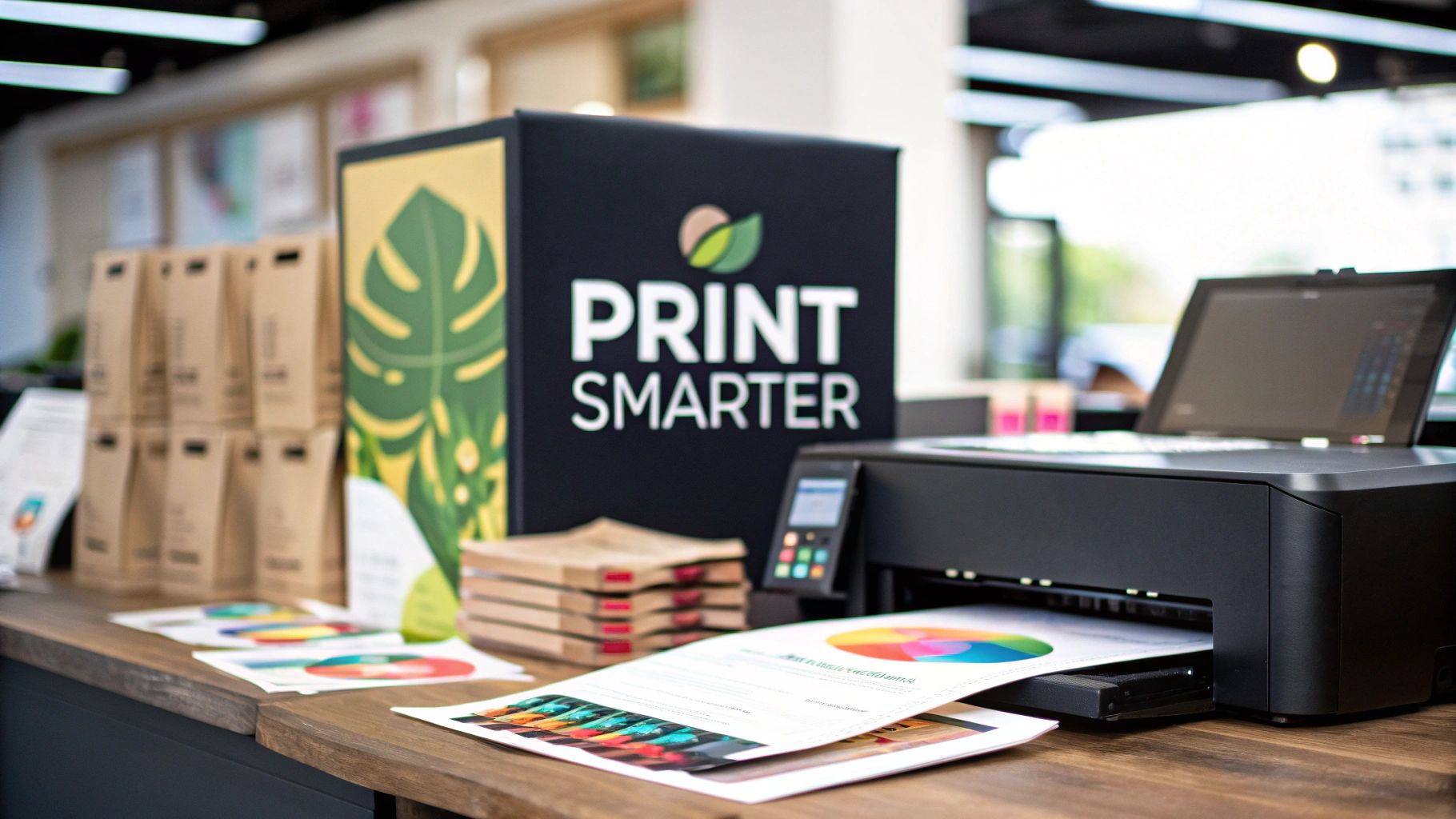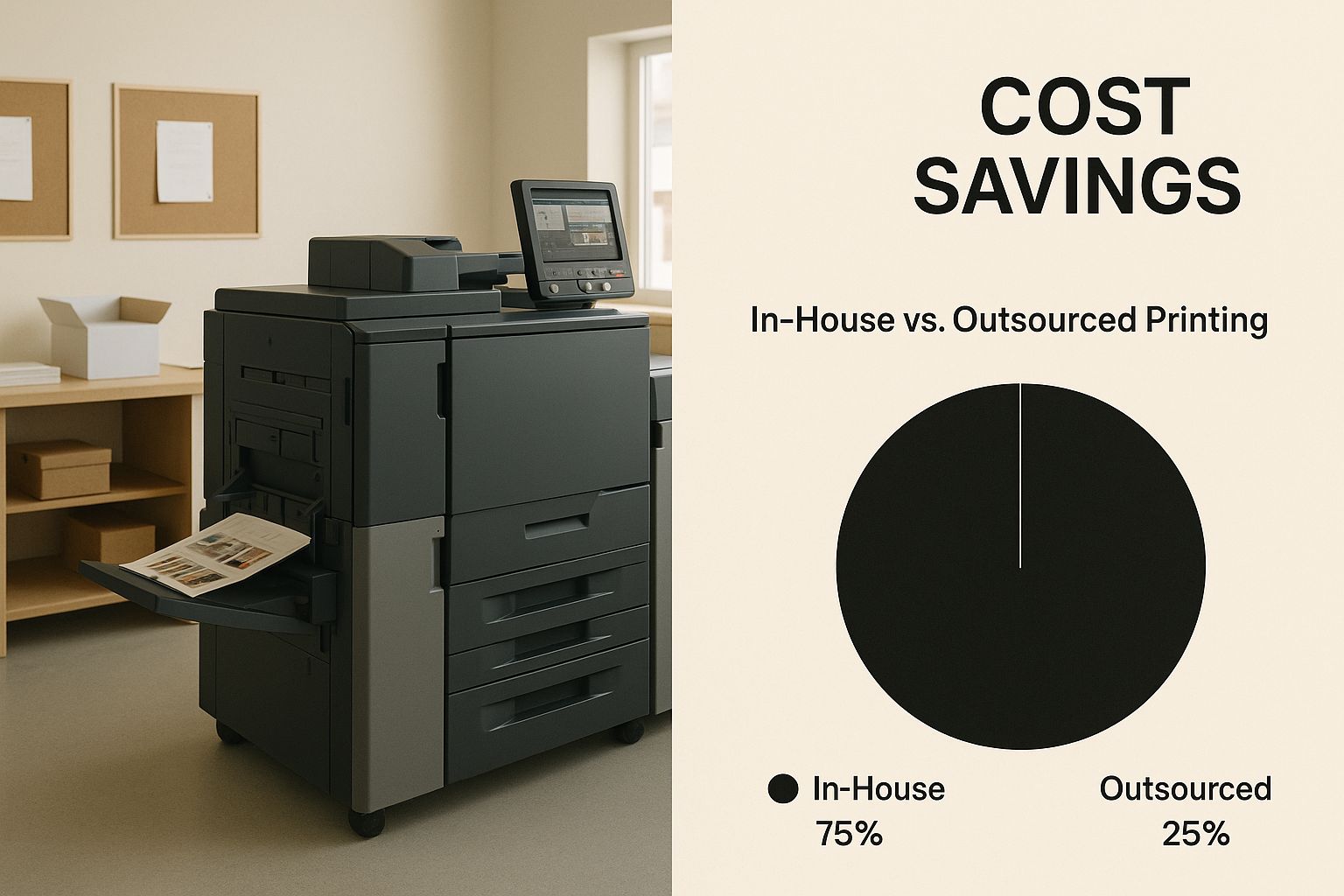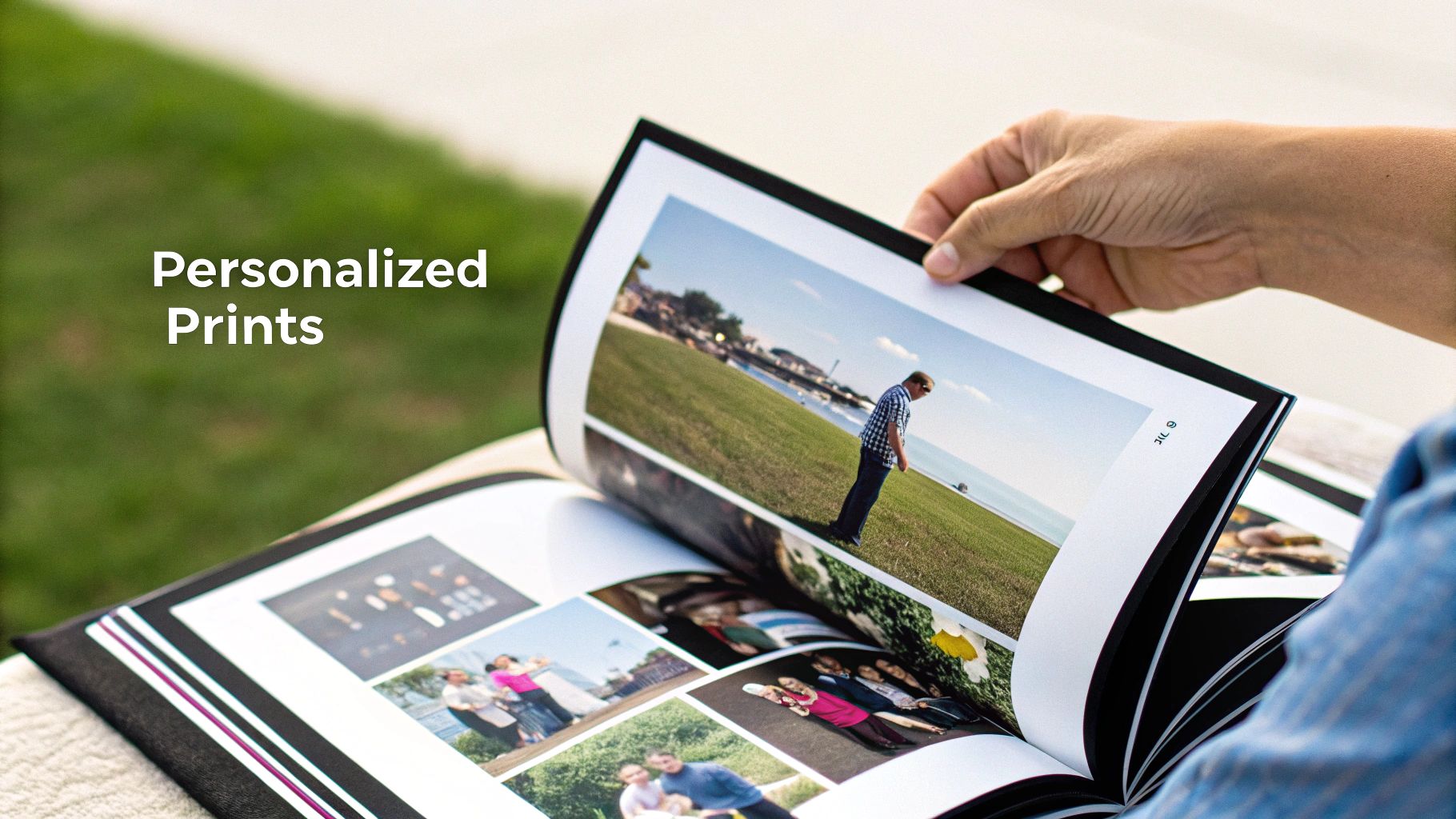Advantages of Digital Printing: Benefits for NZ Businesses

Understanding Digital Printing: A Fresh Look at Decor
Imagine emailing a document straight to your printer. It’s quick, precise, and you don't have to worry about messy ink cartridges. That's digital printing in a nutshell. Traditional printing, on the other hand, is more like sending a letter. It takes time and involves several steps. This difference is changing how we approach printing, offering a new level of flexibility and efficiency. It's not just about speed; it’s about a smarter way to produce.
How Digital Printing Works
The process is surprisingly simple. Your design, whether it's an intricate wallpaper pattern or a simple logo for business cards, is created digitally. This digital file is sent directly to the printer, which uses advanced technology to reproduce the image onto the material. This direct printing eliminates many of the intermediate steps required with traditional printing, like creating plates or films. This streamlined workflow is key to the speed and cost benefits of digital printing. For a visual breakdown of the process, check out this Wikipedia article: Digital Printing. The diagram clearly shows the direct link from digital design to printed result, highlighting the efficiency.
Advantages of Digital Printing
This simplified process unlocks a number of advantages, especially for designers, homeowners, and businesses.
-
On-Demand Printing: Print only what you need, when you need it. This eliminates the need to store large amounts of pre-printed materials, cutting down on storage costs and potential waste.
-
Easy Customization: Each print can be easily adjusted without major setup changes, ideal for personalized marketing materials or unique interior design elements. This level of control allows you to tailor printed materials to specific client needs or individual projects.
To see how these advantages play out in real life, take a look at our production process: Discover More About Our Production Methods. These benefits make digital printing an attractive option for those looking for more control, efficiency, and adaptability in their printing projects.
Speed That Actually Matters: Meeting Deadlines Without The Drama

This infographic shows a busy print shop with a digital press humming away, highlighting how this technology can save you money. It really captures the efficiency and modern feel of digital printing and visually demonstrates how streamlined processes can lead to real financial benefits.
Imagine this: You're in Wellington, gearing up for a big trade show next week. Your brochures are finalized, but then your printer drops a bombshell – a two-week lead time. Cue the panic. This is exactly where the speed of digital printing swoops in to save the day. Unlike traditional printing, which needs lots of setup and processing, digital printing is almost instant. This means you could have those brochures in hand within 24-48 hours, ready to impress at the trade show.
One of the biggest perks of digital printing in New Zealand is how fast it is and how little paper it wastes. For Kiwi businesses that need to react quickly to market changes, this is huge. As technology gets better, more and more companies are switching from traditional offset printing to digital, so they can print high-quality materials exactly when they need them. Discover more insights on the NZ digital printing market.
Seizing Opportunities With Speed
Fast turnaround times mean more than just hitting deadlines. They let New Zealand businesses be truly nimble. Think of a Christchurch cafe owner who suddenly decides to add a new seasonal special to their menu. With digital printing, they can design, print, and have those new menus on tables within a single day, making the most of that limited-time offer. This kind of responsiveness can really set a business apart.
Digital printing also allows for eleventh-hour changes without breaking the bank or causing delays. This flexibility helps businesses roll with the punches or jump on unexpected opportunities. Picture a Queenstown retailer noticing a sudden surge in tourists. They can quickly design and print promotions to grab attention and maximize their impact.
Speed Without Sacrificing Quality
It's crucial to understand that speed doesn't equal a drop in quality. Modern digital presses produce sharp, vibrant prints that are just as good as traditional printing. This means you get both speed and professional-looking materials, boosting your brand and making a great impression on customers.
This speed advantage also applies to proofing. Designers can quickly get a physical copy of their work to review, making revisions faster and streamlining the whole process to the finished product. This back-and-forth process boosts efficiency and makes sure the final print matches the initial design perfectly. At the end of the day, the speed you get with digital printing helps businesses be more responsive, adaptable, and competitive in New Zealand's ever-changing market.
To illustrate the speed differences, let's take a look at a comparison:
Digital vs Traditional Printing: Turnaround Time Comparison
A detailed comparison showing turnaround times for different print jobs between digital and traditional printing methods
| Print Job Type | Digital Printing Time | Traditional Printing Time | Time Savings |
|---|---|---|---|
| Business Cards (500) | 24 hours | 5-7 business days | 4-6 business days |
| Brochures (1000) | 48 hours | 7-10 business days | 5-8 business days |
| Posters (50) | Same day | 3-5 business days | 2-4 business days |
| Flyers (5000) | 2-3 days | 10-14 business days | 7-11 business days |
As you can see, digital printing offers significant time savings across various print jobs. This speed allows businesses to react quickly to market demands and seize opportunities without being held back by lengthy printing processes. The ability to get high-quality prints within a matter of hours or days, compared to weeks with traditional methods, is a game-changer for many New Zealand businesses.
Customization That Connects: Making Every Print Personally Meaningful

This screenshot of Canva shows how easy it is to create personalized designs for digital printing. With simple drag-and-drop tools and ready-made templates, anyone can design custom visuals. This ease of use is a major advantage of digital printing, allowing for unique designs without specialized software or training.
Imagine moving beyond generic marketing and creating materials that truly connect with each customer. Picture promotional postcards that address each recipient by name, showcasing images and offers tailored just for them. This is the power of variable data printing, a key benefit of digital printing.
For example, an interior designer in Wellington could use digital printing to create custom wallpaper featuring a client's family photos. It turns a living room into a truly personal space. This level of customization isn't possible with traditional printing methods. Digital printing is a game-changer for designers and homeowners.
Businesses can also use variable data printing to create targeted marketing. This leads to better engagement and higher conversion rates. Think of an Auckland cafe sending personalized coupons with unique offers based on past purchases.
Building Deeper Connections Through Print
This personalized approach helps businesses build stronger relationships with their customers, encouraging loyalty and making every interaction feel special. To see how this could work for you, explore custom printing options: Learn more about personalized printing at Maak Home.
Digital printing's customization goes beyond individual items, too. Imagine a Dunedin retailer creating limited-edition packaging for a product launch. This adds a unique touch that increases perceived value and creates a sense of exclusivity.
This is a powerful tool for New Zealand businesses. By offering affordable and accessible customization, digital printing helps elevate brands and makes a lasting impression. It’s a major shift from the traditional one-size-fits-all approach to marketing and design. Businesses can now meet the growing demand for personalized and individual experiences. The ability to tailor prints allows for highly targeted messaging, resulting in deeper engagement and increased effectiveness.
Environmental Impact That Actually Makes A Difference

This image captures the spirit of sustainable printing, showing how mindful choices can lessen our impact on the planet. It's a great example of how businesses can balance their printing needs with eco-conscious values. For businesses in New Zealand, sustainability is becoming essential for attracting and keeping customers. Digital printing offers real environmental benefits that go beyond marketing slogans.
Reducing Waste Through On-Demand Production
One of the biggest advantages of digital printing is how it cuts down on waste from overproduction. Think about traditional printing – it often requires large minimum print runs. This leads to extra stock and discarded materials.
Digital printing offers a print-on-demand solution. Businesses can produce exactly what they need, exactly when they need it. This dramatically reduces paper waste and minimizes the overall environmental footprint.
Imagine a small Auckland design studio. With digital printing, they can print the precise number of client presentations they need, instead of hundreds of extras destined for the recycling bin.
Sustainability is a growing priority for Kiwi businesses, especially in the printing industry. Digital printing provides a way to be more sustainable by using energy-efficient equipment and offering print-on-demand services. This not only reduces waste, but also aligns with what customers are looking for in eco-friendly practices. For a deeper dive into sustainability in New Zealand's printing industry, Discover more insights. This thoughtful approach resonates with environmentally conscious New Zealand consumers.
Lowering Energy Consumption and Emissions
Digital printing also consumes less energy compared to traditional methods. Think about the many steps involved in traditional printing – from creating plates to setting up the press and cleaning up afterward. Each step uses a significant amount of energy.
Digital printing simplifies this process, reducing the energy needed for each print job. This results in a smaller carbon footprint and aligns with New Zealand's commitment to sustainability. You might also be interested in Maak Home's Commitment to Sustainability. This focus on efficiency contributes to a more environmentally sound approach to printing.
Addressing Misconceptions About Printing
Printing has sometimes been seen as environmentally unfriendly. However, digital printing offers a more sustainable path. By reducing waste and energy use, it allows businesses to lighten their impact.
Many digital printing companies are going even further. They're using eco-friendly inks and materials to strengthen their commitment to sustainability. This shift towards responsible printing is vital for both the environment and the future of businesses in New Zealand.
By embracing digital printing, companies can show they care about the environment. This attracts eco-conscious customers and contributes to a greener Aotearoa. These practices are not just good for the planet; they also enhance a company's reputation and appeal to a growing base of environmentally aware customers.
Financial Benefits That Transform Your Bottom Line
Let's talk money. While the upfront costs of digital printing might seem a bit higher at first glance, the long-term financial benefits can significantly impact your profitability. Think of it like investing in a quality espresso machine – sure, it's pricier than instant coffee, but the savings and enjoyment add up over time.
Unveiling Hidden Savings
Imagine you're designing a feature wall for a stylish Auckland apartment. You've found the perfect wallpaper, but with traditional printing, you'd likely have to order far more than you need. This leads to wasted rolls and wasted money. Digital printing, however, allows you to order the exact amount required. It's like buying ingredients for a recipe – you get precisely what you need, minimizing waste and saving you precious dollars. This on-demand approach is particularly beneficial for smaller projects or for businesses with limited storage.
Traditional printing often involves significant setup costs, like creating screens or plates. These can be substantial, especially for smaller print runs. Digital printing sidesteps these setup expenses, making it a much more cost-effective choice for bespoke designs or limited editions. Think of a Christchurch café wanting custom-printed coffee cups – digital printing removes those hefty initial setup fees.
Calculating Your True Printing Costs
Many businesses focus solely on the sticker price of printing, overlooking hidden costs that can quickly add up. Consider the expenses associated with storing excess inventory, the risk of materials becoming outdated, or the time spent managing large print runs. Digital printing significantly reduces these hidden costs, often resulting in a lower overall expenditure. For more details on pricing and costs, check out our FAQs.
The printing industry in New Zealand has been shifting. While traditional methods have seen a decline, with a CAGR of -5.4% in recent years, digital printing offers a more adaptable and cost-effective solution. Revenue in the printing sector is estimated to reach $1.3 billion by 2024, showcasing the evolving landscape and the growing opportunities within digital printing. You can find more insights on the New Zealand printing industry at IBISWorld.
Real-World ROI
While the initial investment in digital printing equipment might seem like a big step, the return on investment (ROI) can be impressive. Imagine a Dunedin architect needing high-quality presentations for clients. Investing in a digital printer eliminates the costs and delays of outsourcing, resulting in faster turnaround times and potentially higher profit margins.
Digital printing allows for a more nimble and responsive approach. This translates into quicker project completion, happier clients, and a healthier bottom line for New Zealand businesses. This flexibility gives you greater control, empowering you to make smarter financial decisions.
To illustrate the financial benefits, let's look at a cost analysis:
To help illustrate the potential financial benefits, let’s take a look at a practical cost comparison.
Cost Analysis: Digital Printing Investment vs Returns
| Business Size | Initial Investment | Monthly Savings | Break-even Period | Annual ROI |
|---|---|---|---|---|
| Small | $5,000 | $200 | 25 months | 48% |
| Medium | $15,000 | $750 | 20 months | 60% |
| Large | $50,000 | $2,500 | 20 months | 60% |
This table provides estimated figures for illustrative purposes. Actual results may vary depending on specific business needs and usage.
As the table shows, while the initial investment varies depending on the scale of your operation, the potential for significant monthly savings and a strong annual ROI is consistent across different business sizes. The break-even period also demonstrates how quickly digital printing can start paying for itself.
Quality And Versatility: Professional Results That Exceed Expectations
Remember the days when "digital printing" meant blurry images and faded colors? Thankfully, those days are long gone. Modern digital printing delivers truly professional results, often surpassing traditional methods in consistency, color accuracy, and finish options. Let's explore how digital printing handles everything from everyday business cards to intricate specialty wallpaper.
High-Quality Output Across Various Applications
Imagine you're printing a vibrant, detailed photograph. With older printing methods, getting consistent color across a large order could be a real headache. But digital printing ensures precise color reproduction on every single piece, whether you're printing 50 or 500. This consistency is key for maintaining a strong brand identity and making sure your materials look top-notch. Think of a design firm printing client presentations – every page will have the same sharp images and accurate colors, leaving a professional impression.
Digital printing also shines when it comes to fine details. Picture a complex geometric pattern for wallpaper. Digital printing can reproduce the finest lines with remarkable clarity, something that could be tricky with traditional methods. This precision unlocks new possibilities for interior designers and homeowners looking for truly unique decor.
Versatility Without The Setup Costs
One of the biggest perks of digital printing is its versatility. Unlike traditional printing, which often comes with hefty setup costs for different materials, digital printing lets you switch between projects seamlessly. This means you can play around with different paper stocks, fabrics, and finishes without breaking the bank. This is a game-changer for small businesses and creative professionals. A small business can easily print brochures on glossy paper one day and then switch to custom-designed tote bags on canvas the next.
This adaptability extends to finishes too. Digital printing offers a wide array of options, from matte to gloss, textured to smooth. This lets businesses and designers get creative and achieve the perfect look and feel for their projects. Imagine an interior designer creating custom wallpaper with a unique textured finish—digital printing makes this level of personalization both achievable and affordable.
Evaluating Quality and Choosing the Right Partner
When considering digital printing, it's helpful to understand the quality benchmarks and how to evaluate potential printing partners. Look for providers who use high-resolution printers and quality inks. Ask about their color management process and request samples to see their work firsthand. A reputable printer will be happy to walk you through their process and showcase their capabilities.
By understanding the quality and versatility of digital printing, businesses can create more impactful marketing materials, strengthen their brand, and explore new creative avenues. This technology empowers businesses to achieve professional results that not only meet but exceed expectations. It's all about finding the sweet spot between quality, flexibility, and affordability—essential ingredients for success in today's market.
Your Practical Roadmap: Making The Smart Switch To Digital Printing
Ready to explore digital printing for your New Zealand business? This section is your step-by-step guide to making a smart move and a smooth transition. We'll walk you through the essential questions to ask potential printing partners, the quality you should expect, and the workflow changes that will really benefit your business.
Evaluating Digital Printing Providers
Choosing the right digital printing partner is crucial. It's a bit like choosing a builder for your dream home – you wouldn't just pick the first one you see, would you? You'd do your research, ask a lot of questions, and probably check their references. The same applies to digital printing. Here’s a checklist to help you evaluate potential providers:
-
Location and Accessibility: Is the provider conveniently located, or will shipping add significant time and cost? For New Zealand businesses, a local provider often simplifies logistics.
-
Technology and Equipment: What printing technology do they use? Is their equipment current and capable of handling your specific needs? Don’t hesitate to ask for a tour of their facilities – it’s the best way to get a feel for their operation.
-
Experience and Expertise: How long have they been in business? Do they have experience working with businesses like yours? Look for a provider who understands the unique requirements of your industry.
-
Customer Service and Support: Are they responsive and helpful? Do they offer ongoing support if you run into any snags? Good communication is key to a smooth printing process.
Key Questions To Ask Potential Partners
Asking the right questions can reveal a provider’s true capabilities. Here are some essentials:
-
What are your typical turnaround times? This is crucial for understanding how quickly you can expect your materials.
-
Can you provide samples of your work? Seeing and feeling the quality firsthand is incredibly important, especially on materials similar to what you’ll be using.
-
What’s your process for revisions and corrections? Knowing how they handle changes can save you a lot of headaches.
-
What are your quality control measures? Understanding their quality assurance process helps ensure consistent results.
-
What’s your pricing structure? Transparency is vital – make sure there are no hidden costs lurking around the corner.
Structuring a Successful Trial Program
Before committing to a long-term partnership, think about running a trial program. This allows you to test the waters and gain confidence in the provider's abilities. It’s like a test drive before buying a car. Here's a simple structure:
-
Start Small: Begin with a small, low-risk project to assess quality, turnaround time, and communication.
-
Clearly Define Your Needs: Provide specific details for the trial project – materials, quantities, deadlines, the whole nine yards.
-
Evaluate the Results: Carefully examine the finished product. Was the quality up to par? Did they meet the deadlines? How effective was their communication throughout the process?
-
Provide Feedback: Share your feedback with the provider, both good and bad. This helps them better understand your needs and refine their services.
Tracking Your Transition to Digital Printing
Once you’ve chosen a provider, it’s important to track your progress. Here are some key metrics to watch:
-
Cost Savings: Compare your printing costs before and after the switch. Are you saving as much as you anticipated?
-
Turnaround Time: How quickly are you receiving your printed materials? Are deadlines being met consistently?
-
Customer Satisfaction: If you’re using digital printing for marketing materials, has customer engagement improved?
-
Waste Reduction: Are you producing less waste compared to traditional printing?
By following these steps, you can make a smooth transition to digital printing and enjoy all its advantages. It's all about making informed choices, building strong relationships with your providers, and keeping track of how things are going.
Ready to transform your interiors with sustainable, custom-made designs? Explore the possibilities at Maak Home.









